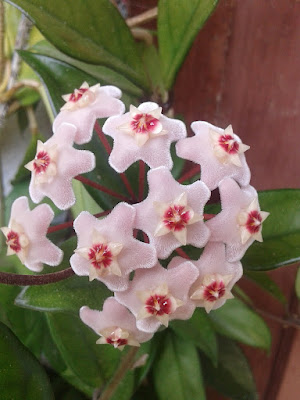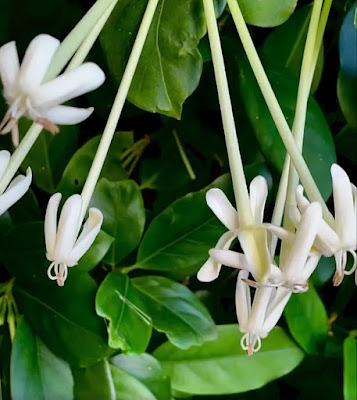 |
| Conomorpha fragrans |
DESIGN ELEMENTS
Climber Heroes
This design series is about plants that are categorised as non-general lines.Every week I’ve been saying that were talking about plants that you won’t necessarily find in your big box store or possibly even in your nursery so you may have to search for them.
These plants are so worthwhile that because they provide year round interest with their foliage colour, texture and contrast, not just their flowers.
Today perhaps some climbers fit the bill
Peter refers to cool sub-tropical garden or ‘cool sub-trops’ which means that overnight winter temperatures are down to about 5 degrees.
Don’t be put off if you live in a different climate because often plants adapt to a variety of climatic conditions and are worth a try.Peter mentioned these climbers
Conomorpha fragrans often called climbing frangipani although it has nothing to do with the frangipani genus-Plumeria. The flower does look similar to the frangipani flower and are highly scented.
Hoya carnosa - vigorous habit requiring a solid support
- in cooler areas plant against a north facing wide. Deciduous in cold areas.
- Dombeya ianthotrycha (tropical garden society of Sydney)-a winter flowering climber with large paper thin leaves. Flower colour is a muted red with a hint of orange. Can be trained as an espalier or a bun shaped shrub.
- Hoya carnosa or wax flower, better in pots with specialised potting mix. If planting in the ground, must have well drained soil.
- TIP: don't cut those flowering spurs off - this
Climber Shrubs
This design series that covers everything from mixed shrub borders, sub-shrubs, climbers, hero trees to best garden bromeliads but use plants that are non-general lines.I have to say, Peter Nixon, RWG’s contributor for this series, focuses largely on what he calls cool sub-tropical garden or ‘cool sub-trops’ which he refers to often.
Don’t be put off if you live in a different climate because often plants adapt to a variety of climatic conditions and are worth a try.
 |
| Hibiscus geranioides |
Climber shrubs-what are they and how could I use them as 'garden fixes’ in
my cool subtrops garden ?
Seems like a contradiction because climbers need support to climb whilst shrubs are free standing. But what about those plants that climb over themselves to form a sort of mounding shrub?
Some of these types of shrubs are self-striking which might be called suckering.
Insta examples from Peter Nixon
Juanaloa aurantiaca - or commonly called Golden Fingers because the flowers look like a little bunch of lady finger bananas. Minimum winter overnight 6-7 degrees C
Gmelina philipensis - 'Parrot Beak'. A deciduous shrub with unusual yellow flowers that resemble a parrot beak.
Hibiscus geranoides-native to Australia. Loves a 'La Nina' type of weather. Interesting foliage texture
Bauhinia tomentosa-sulphur flowering semi-deciduous shrub to 3m with a cascading habit.




